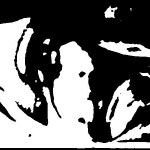fmri
I’ve heard that for some the experience of undergoing an MRI scan is claustrophobic, but I find it oddly comfy and cocoon-like. OK, there are those gear-grinding screeches and thumps interrupting the music in the earphones. And the cumbersome set-up for imaging breasts, along with the usual admonition to keep perfectly still, does not leave me in a position I would choose for a nap. Still, I’m on the verge of dropping off when the whole table starts shaking under me. They had warned me about this before I climbed onto the apparatus, but for a second I’m not sure whether to laugh (without…
Solar cells made with bismuth vanadate achieve a surface area of 32 square meters per gram. This compound can be paired with cheap oxides to split water molecules (and make hydrogen) with record efficiency.
Short-term geoengineering could postpone global warming, only to have it happen more quickly in the future.
Carotenoids tinge blackbird bills a deep orange, signalling fitness; birds with oranger bills are "are heavier and larger, have less blood parasites and pair with females in better condition than males with yellow bills."
Fibroblasts can extrude a tidy biological…
Today's science news from the Weizmann Institute covers research in neurobiology, environmental science and cancer immunology.
⢠In the first, scientists identified a likely biological marker for autism that shows up even in very young children. Diagnoses of autism are generally not possible so early, as the signs typically appear gradually throughout the first 3-4 years of life. The scientists used fMRI to scan the brains of children aged 1-3 who were just starting to show signs of autistic behavior. Their method: scanning the brains of toddlers while they sleep. It seems that even asleep…
Do you ever doubt your own memory? New research at the Institute suggests that some of the things we think we remember could be wrong. It seems that our brains are surprisingly willing to exchange a true memory for a false one, just on the basis of friends' claims. The scientists not only demonstrated just how easy it is to create false memories, they showed that the switch in memory has a signature pattern of brain activity. The most significant feature? They found strong connectivity between areas of the brain known to be involved in memory and learning, and the amygdala, which, among other…
Today's Weizmann Institute news stories include two new papers from the prolific lab of Prof. Yadin Dudai. The first is on a protein that boosts memory in rats. Dudai and his group have been investigating this protein for several years. Previously, they had managed to show that blocking the protein, even for a very short time, erases memories. Now, they have demonstrated that adding more of the protein to certain areas of the brain can strengthen memory. Note: They increased the protein via gene-carrying viruses that infiltrated the rats' brain cells - not a clinic-ready technique. But until…
Anne Dillard said "You can't test courage cautiously," but Institute scientists have found a way to test it fairly safely, at least.
One might think of courage as an abstract idea, but it turns out that acts of bravery reveal a unique activity pattern in the brain. An experiment at the Institute to identify the brain mechanisms that take control when the call to action conquers fear involved a live snake on a remote-controlled trolley and volunteers with a fear of snakes in an fMRI.
FOR most of us, the ability to navigate our environment is largely dependent on the sense of vision. We use visual information to note the location of landmarks, and to identify and negotiate obstacles. These visual cues also enable us to keep track of our movements, by monitoring how our position changes relative to landmarks and, when possible, our starting point and final destination. All of this information is combined to generate a cognitive map of the surroundings, on which successful navigation of that environment later on depends.
Despite the importance of vision for navigation,…
In reverse order:
5. Â David Sloan Wilson, pissing off the angry atheists.
"I piss off atheists more than any other category, and I am an atheist." This sparked some lively action in the comments.
4. Lively or not, Wilson and Dawkins lost fourth place to snail jokes.
A turtle gets mugged by a gang of snails. 
3. A walking tour that lets you See exactly where Phineas Gage lost his mind
Â
2. "Push" science journalism, or how diversity matters more than size
We're constantly told -- we writers are, anyway -- that people won't read long stories. They're…
OF all the techniques used by neuroscientists, none has captured the imagination of the general public more than functional magnetic resonance imaging (fMRI). The technique, which is also referred to as functional neuroimaging and, more commonly, "brain scanning", enables us to peer into the human brain non-invasively, to observe its workings and correlate specific thought processes or stimuli to activity in particular regions. fMRI data affect the way in which people perceive scientific results: colourful images of the brain have persuasive power, making the accompanying data seem more…
Gleanings from empathetic ravens, lying brains, dying converence, fading vocabularies, and new books
Ravens via PDPhoto
Ravens show that consoling one another is also for the birds, Yet another finding that other species have qualities previously thought uniquely human. Our greatest distinction is that we're highly social. Yet in that we've got a lot of company.  
Human brains excel at detecting cheaters. FMRI's, not so much, says Vaughan Bell at Mind Hacks-- though in yet another court case, the fMRI lie detection industry pushes another story.
Bell also has a nice write-up of of scintillating RadioLab program on how early dementia shows up in use of language. A…
GAMBLING is extremely popular, with lottery tickets, casinos, slot machines, bingo halls and other forms of the activity generating revenues of more than £80 billion each year in the UK alone. For most people, gambling is nothing more than an entertaining way to pass the time. But for some, it becomes a compulsive and pathological habit - they spend increasing amounts of time gambling, because tolerance builds up quickly, and experience withdrawal symptoms when they aren't gambling.
The terms "tolerance" and "withdrawal" are normally associated with drug addiction, and indeed pathological…
SUBJECTIVE experience poses a major problem for neuroscientists and philosophers alike, and the relationship between them and brain function is particularly puzzling. How can I know that my perception of the colour red is the same as yours, when my experience of the colour occupies a private mental world to which nobody else has access? How is the sensory information from an object transformed into an experience that enters conscious awareness? The neural mechanisms involved are like a black box, whose inner workings are a complete mystery.
In synaesthesia, the information entering one…
Would you believe this brain?
Every few months, sometimes more often, someone tries to ramrod fMRI lie detection into the courtrooms. Each time, it gets a little closer. Wired Science carries the latest alarming story:
A Brooklyn attorney hopes to break new ground this week when he offers a brain scan as evidence that a key witness in a civil trial is telling the truth, Wired.com has learned.
If the fMRI scan is admitted, it would be a legal first in the United States and could have major consequences for the future of neuroscience in court.
The lawyer, David Levin, wants to use that…
WHEN making moral judgements, we rely on our ability to make inferences about the beliefs and intentions of others. With this so-called "theory of mind", we can meaningfully interpret their behaviour, and decide whether it is right or wrong. The legal system also places great emphasis on one's intentions: a "guilty act" only produces criminal liability when it is proven to have been performed in combination with a "guilty mind", and this, too, depends on the ability to make reasoned moral judgements.
MIT researchers now show that this moral compass can be very easily skewed. In a new study…
Click to enlarge images
ARTISTS employ a number of different techniques to represent implied motion in two-dimensional works. One of these, commonly used in posters, comics and animation, is the affine shear effect, whereby a moving object is depicted as leaning into the direction of movement. Cartoonists also use action lines to depict movement and speed, with straight lines conveying fast movements and wavy lines conveying slower ones. Motion can also be conveyed by superimposing several images showing the successive positions of a movement, or by a blurred image showing the different…
Cordyceps in glass, by glass artist Wesley Fleming -- a strange depiction of a rather horrid business. For more, do go to the source, the lovely Myrmecos Blog, which is all about bugs.
Now, the best of the week's gleanings. I'm going to categorize them from here out, and at least try to keep them from being from completely all over everywhere about everything.
Mind, brain, and body (including those gene things)
While reading Wolpert's review of Greenberg's book about depression (he didn't much like it), I found that the Guardian has a particularly rich trove of writings and resources on…
FORMATION of a memory is widely believed to leave a 'trace' in the brain - a fleeting pattern of electrical activity which strengthens the connections within a widely distributed network of neurons, and which re-emerges when the memory is recalled. The concept of the memory trace was first proposed nearly a century ago, but the nature of the trace, its precise location in the brain and the underlying neural mechanisms all remain elusive. Researchers from University College London now report that functional magnetic resonance (fMRI) can be used to decode individual memory traces and to predict…
HOW does the brain encode the spatial representations which enable us to successfully navigate our environment? Four decades of research has identified four cell types in the brains of mice and rats which are known to be involved in these processes: place cells, grid cells, head direction cells and, most recently, border cells. Although the functions of most of these cell types are well characterized in rodents, it remains unclear whether they are also found in humans. A new functional neuroimaging study, by researchers from University College London, published online in the journal Nature,…
"WHEN a man sits with a pretty girl for an hour," said Albert Einstein, "it seems like a minute. But let him sit on a hot stove for a minute, and it's longer than any hour." Einstein was describing one of the most profound implications of his Theory of General Relativity - that the perception of time is subjective. This is something we all know from experience: time flies when we are enjoying ourselves, but seems to drag on when we are doing something tedious.
The subjective experience of time can also be manipulated experimentally. Visual stimuli which appear to be approaching are perceived…
In neuroscience, we spend most of our time trying to understand the function of the "normal" brain -- whatever that means -- hence, we are most interested in the average. Under most occasions when scientists take an interest in the abnormal neurology, it is usually someone with who has something wrong with them -- has brain damage or a disorder of some kind. In these cases, we try and understand what brain functions they have difficulty performing as a way to understand what each part of the brain does (and hopefully to someday be able to help them).
The point is that when neurologists…


